TELLING THE DIFFERENCE BETWEEN STOCKED OR SEMI-WILD FISH
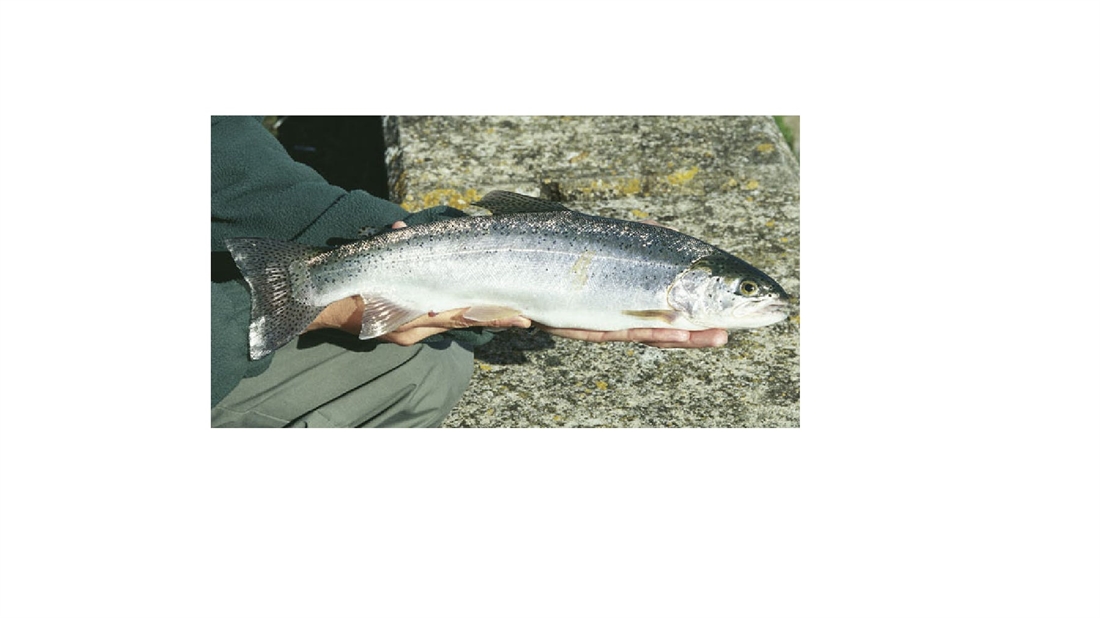
In most fisheries, whether stillwater or rivers, there’s likely to be a mixture of recently stocked fish and those which have survived since being stocked a few seasons ago. In a commercial fishery the former will be by far the most abundant.
Overwintered fish would have adapted to their new environment to survive as well as avoided being caught or eaten by a predator. There are some general rules for telling fresh stockies and overwintered trout apart.
FRESHLY STOCKED TROUT
Freshly stocked fish are at their highest risk of being caught. Studies show that over 95% disappear either through being caught, death through natural causes or predation. These naïve stockies are generally active and least wary. They’ve been in an environment that conditions them to compete actively for food. This means they will have a go at pretty much anything that resembles food.
Scientific studies show they feed poorly for the first few months as they are unaware of the value of many natural foods or how to catch them. This lack of feeding is less of a consequence than for humans, fish can survive without food for more than six months at a push, and this gives them a long time to find food. They will learn to find food in their new environment but as they are establishing these skills they are most likely to be caught.
They’ll gradually become more wary, not just of anglers but of other potential predators. If they don’t they get caught and removed. Stocked fish can therefore be identified by their behaviour, they move around the fishery “exploring”. These fish are less likely to establish themselves in an area where overwintered fish are present. They will also be less wary of potential hazards such as anglers! Those few fish that don’t get caught or eaten will become semi–wild. Next season, they’ll present a more challenging quarry as they are wary of perceived danger and therefore have less chance of being caught compared to fresh stockies.
TELL THE DIFFERENCE
During their time in the fishery these overwintered fish will have undergone physical as well as behavioural changes. It is these physical changes that we can often use to identify them from the recently stocked fish.
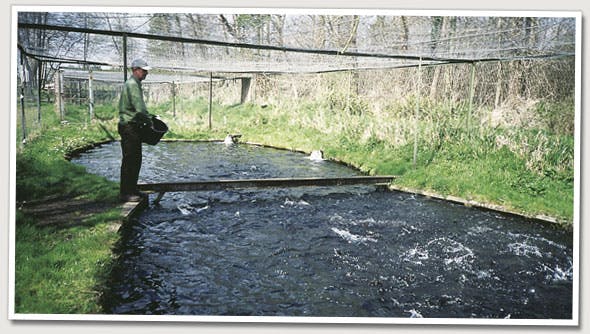
FAT CONTENT
Newly stocked fish will have been fed on a diet of trout pellets and grown at a commercial rate to ensure they meet market size requirements. In doing this the energy intake of these fish (i.e. fuel in the form of food) will have been more than they need to grow muscle, and the excess nutrients particularly fat will be stored in the muscle tissue and viscera (a thin layer of flesh).
Stocked fish often look fatter in the body than wild fish. This isn’t extra muscle but the body cavity and muscles filled with excess fat. This is particularly pronounced around the abdomen, the fish often looking “plumper”. An overwintered fish will look much more slender.
This extra fat isn’t as much of a problem to a trout as it would be to a human. Trout are able to use these fat reserves very effectively. In fact they use fat as the main source of energy, unlike humans that tend to use carbohydrates for this. A normal rainbow trout is capable of eating and growing well on food with a fat content in excess of 25 per cent. If we tried that it would kill us off in a matter of weeks!
One of the problems of all this fat is that it can interfere with muscle function so it’s no surprise that these trout don’t fight as well as leaner fish. The fat is used to power the muscles but it interferes with their ability to contract effectively and supply sufficient energy long term.
An overwintered fish has lost all this puppy fat with a long period of poor feeding and then living off natural foods with lower fat contents than trout food in farms. They will also have had to become far more active to survive and so generally are a fitter, leaner animal.
This is usually obvious once hooked, both give an initially good performance but the stocked fish is more likely to tire quickly and also be far less aware of potential snags.
THE FLESH AND BODY CAVITY
The eating qualities of the two are also very different, the lack of fat in an overwintered fish means that it retains less moisture when cooked and is therefore dryer.
The flesh firmness is also different with the recently stocked fish having softer flesh. The body cavity and viscera of a recently stocked fish are generally much fattier than with overwintered.
The stomach and pyloric caecae (finger-like projections around the stomach) are generally embedded in fat. Wild or overwintered fish rarely have sufficient food to lay down this much fat and so the u-shaped stomach and pyloric caecae are easily distinguished in the viscera.
SKIN COLOUR
The skin pigmentation may be used to identify overwintered fish. These often have well-defined spots and strong skin pigmentation, which is less defined in farmed fish. The pigment in the skin is vital in wild fish for camouflage, they also experience a wide variety of light levels in the wild. On a farm the light is more constant and so they tend to have less well-developed skins to enable changes in colour.
The colour of the flesh is influenced by whether the fish has eaten the required pigments to turn the flesh pink (below left).
This can be in the food fed on the farm or in eating a lot of shrimps in the wild, either way the chemicals are pretty much the same thing.
Trout that have been in a fishery some time will have a more varied diet with regard to pigment content so the flesh is generally much less pigmented as the pigment in the muscle gets used up in eggs and the skin (below right). But, trout in habitats where shrimps are not a major part of their diet will have white flesh, just like farmed trout fed on food without the pigment.
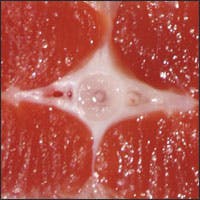
FINS AND TAIL
Body condition, particularly the fins, can be used to determine whether a fish is freshly stocked.
The fins of farmed fish are much more prone to erosion and damage; some table farmed fish can erode some fins completely. This damage will be most pronounced at the edge so look for fraying and a white edge, which is damaged skin. This is particularly noticeable on the dorsal fins of trout. It is quite difficult for a farm to get really good dorsal fin quality prior to stocking.
The other most common damage is splitting. This is common on farmed fish but much less so in trout that have been in a fishery for a while, as splits repair and are less likely to happen.
The tail or caudal fin is another good indicator. A clear, well-defined tail is usual in wild or overwintered fish. It will have clearly defined points at the tips, generally missing on a recently stocked fish. A wild fish is highly dependent on its fins for survival and so they are much less susceptible to damage. The fins will re-grow over time so an overwintered fish is likely to have relatively good quality fins.
Some fin damage can take a long time to re-grow and severely damaged fins may remain stumps.
Stocked fish generally have good quality fins compared to table farmed fish, and the relative damage they suffer depends on the type of system they are grown in.
This demand for increased fin quality means the prices paid for stocking quality trout are much higher as the farm has to grow them on in less economic systems at much lower stocking densities. This ensures that the fin quality of the fish is much higher.
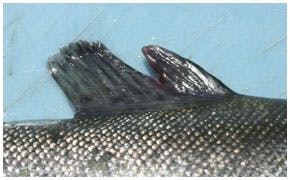
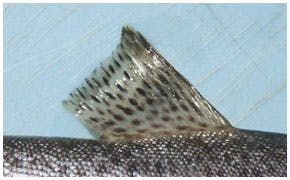
AT A GLANCE…
FRESHLY STOCKED RAINBOW

1 Intensely farmed trout will often have ragged or split tails and fins due to tail-nipping by other fish, rubbing against concrete raceways and handling through grading. From fingerling to stocking, a fish may be graded three or four times
2 Greater fat deposits in the muscle restrict contraction
3 Pale skin colour
4 Fatty body cavity with various organs less defined
5 Pink flesh as some food pellets contain dye to make the flesh more attractive
WILD BROWN TROUT
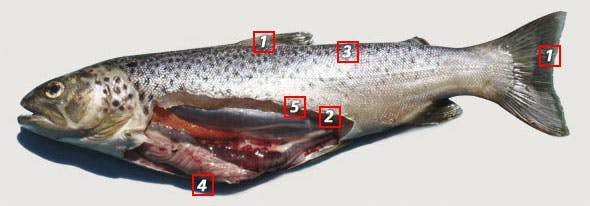
1 The freedom to swim in open water allows fin damage to repair helping full fins and sharp tails to develop
2 Muscle is leaner and therefore fish fight hard for longer periods
3 Skin colour is more pronounced and defined to aid camouflage
4 Hardly any fat in the body cavity means all organs are easily distinguished
5 Wild trout only have pink flesh when their diet is mainly shrimp-based. Otherwise flesh is pale, almost white





